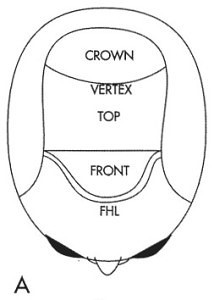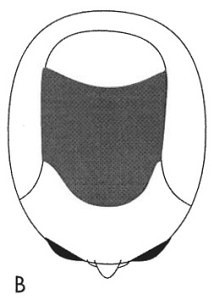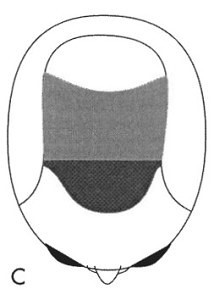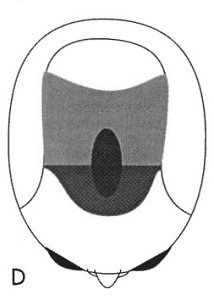Artistry & Aesthetics
Artistry & Aesthetics
The “art” of the hair transplant is to strike the right balance between simply achieving “coverage” and producing a pattern recognised as being natural.
Limited Donor Hair Supply
The area at the back and sides of the scalp, known as the donor area, contains hair follicles that are genetically resistant to the hormone dihydrotestosterone (DHT), which causes hair loss. These DHT-resistant follicles are typically used in hair transplant surgery.
One of the main challenges with hair transplant surgery is the limited number of donor follicles available on a person’s scalp. Therefore, even with various hair transplant techniques, it may not be possible to fully replace all the lost hair, especially in cases of extensive balding. This limitation poses an important question for hair transplant surgeons: how to effectively allocate the available donor hair to address the balding areas of the scalp.
Each square millimetre (mm2) of the scalp typically contains, on average, just slightly less than one follicular unit, which contains from 1 to 4 hair follicles (or an average of 2.2 hairs/follicular unit). So, the average density of a typical non-bald scalp is about two hairs/mm2.
The donor area contains about 25% of a person’s total scalp hair; however, only about half of the donor supply (12.5% of total hair) can be harvested without the thinning becoming noticeable. If all the available donor hair (12.5% of total hair) were used to uniformly cover an area six times larger (the 75% of the scalp that is susceptible to balding), the resulting density would be at most 1/6th the original density of 2 hairs/mm2, or 0.33 hairs/mm2.
While uniform coverage of 0.33 hairs/mm2 would improve the appearance of a patient with extensive balding, a hair restoration surgeon can create an even more aesthetically pleasing look by adjusting the distribution of that hair — i.e., by increasing it in some areas and decreasing it in others.
Aesthetic Distribution of Follicular Units
To optimise the cosmetic outcome of hair transplant surgery with a limited number of follicular units, hair transplant surgeons typically divide the balding area into three regions:
- Frontal hairline (FHL) and front of the scalp
- Mid-scalp (formerly called the top or vertex)
- Vertex/crown
It is commonly observed that a typical scalp has a density of approximately two hairs/mm2. However, hair loss of up to 50% can occur before it becomes visibly noticeable. Therefore, the target post-transplant density in the most cosmetically significant region of the scalp should be around one hair/mm2, as anything higher would not only be unnecessary but also result in the wastage of follicular units.
Below are a few scenarios for a typical Norwood Class VI patient who requires 2,500 follicular units to cover the front and top of the scalp, plus the aesthetic considerations behind each scenario.
Example 1: Uniform Distribution
If 2,500 follicular units, containing a total of 5,000 hairs, were uniformly distributed over the 20,000 mm2 of the front and top of the scalp (see Figure B), the resulting density would be 0.25 hairs/mm2. As discussed above, this is more aesthetically pleasing than an extensively bald scalp, but it is still well short of the ideal post-transplant density of 1 hair/mm2.
Example 2: Forward Weighting
Since people are viewed from the front or at a ¾ angle, the surgeon can use this aesthetic consideration to enhance the hair restoration design. By “forward weighting” the distribution of follicular units (see Figure C), the aesthetic result of the hair transplant will be increased fullness in the front compared to uniformly distributed follicles.
In this example, we place 1,000 follicular units, or 2,000 hairs, into the frontal region (5,000 mm2) for a density of 0.4 hairs/mm2. The remaining 1,500 follicular units (or 3,000 hairs) would then be placed into the mid-scalp region (15,000 mm2) for a density of 0.2 hairs/mm2.
Using the “forward weighting” technique, the front is now twice as dense as the mid-scalp and the overall appearance of the patient is dominated by the frontal view.
Example 3: Enhanced Forward Weighting
We can further improve a “forward weighting” distribution with “enhanced forward weighting.” In this technique, the surgeon places larger follicular units in the mid-portion of the frontal scalp (see the black oval in Figure D). This “forelock” type of distribution will add even more fullness to this most cosmetically-important part of the scalp.
These three examples illustrate how the physician can distribute limited donor hair to the balding areas in a way that provides the best aesthetic outcome for the hair transplant.




Restoring the Frontal Hairline
Creating or restoring a natural-looking frontal hairline is one of the most important aspects of hair restoration surgery. In the past, physicians would use large-graft “plugs” to create the hairline, which is now considered outdated and unnatural. This is because a natural hairline is irregular and starts with small, 1-hair follicular units instead of large clumps of hair. Additionally, a mature individual’s natural hairline begins a bit higher up on the forehead than a young person’s.
A modern hair transplant surgeon can use original methods better to match the look of one’s natural hair.
Follicular Unit Size & Spacing
By following this natural progression of hair follicles, hair transplant surgeons can create a more natural-looking hairline that blends seamlessly with the surrounding hair. This technique is often referred to as the “follicular unit transplantation (FUT) hairline design” or the “follicular unit extraction (FUE) hairline design”. The precise design of the hairline will depend on the patient’s facial features, age, and degree of balding, as well as the surgeon’s experience and artistic sense.
Symmetry
Although symmetry is typically considered an essential aspect of beauty, the natural appearance of the frontal hairline is not entirely symmetrical. Instead, it is irregular in shape and placement. Therefore, a hair transplant surgeon must balance symmetry and irregularity to achieve a natural-looking hairline. The surgeon can create this effect by placing around 100 one-hair follicular units in a range of triangular shapes in front of a symmetrical band of staggered one-hair units, which can be one to three rows deep. This placement method mimics the hairline’s natural irregularity while maintaining some degree of symmetry.
Mature Hairline Position
It’s important to recreate the patient’s mature hairline instead of a low hairline from their youth. The mature hairline is generally located about 1.5-2.5 cm above the highest crease of the furrowed brow. Recreating the mature hairline will provide a natural frame for the face and avoid creating an unnatural appearance.
Hair transplant surgeons need to have open and honest conversations with young patients about the aesthetic considerations of the procedure. Young patients often desire to restore their hairline to its adolescent position. Still, educating them about the benefits of a mature hairline and the potential risks associated with transplanting the hairline too low is essential. In addition, hair transplant surgery is permanent, and patients must understand the long-term aesthetic implications.
Establishing the frontal hairline in the correct position is the most important function of the first hair transplant procedure.
Recipient Sites & Hair Direction
Recipient sites are crucial in hair transplant surgery because they determine the direction and angle of elevation of the hair as it grows out of the scalp. These tiny holes are created in the recipient area of the scalp, where follicular unit grafts will be implanted. How the recipient sites are created is important because it influences the final appearance of the transplanted hair.
Racial Considerations in Hair Transplant Design
Variations in follicular unit density (units/mm2), hair density (hairs/mm2), and predominant hair grouping can be observed among patients of Caucasian, Asian, and African descent. Consequently, it is essential to consider these variations when designing a hair transplant for these patients.
Transplanting Asian Hair
Transplanting Asian and Caucasian hair is similar, except when dealing with Asian patients with coarse, straight hair and light skin. In such cases, the surgeon should incorporate more single-hair follicular units in the transition zones from the bald area of the scalp to the denser regions of the transplant.
Although coarse straight hair can provide more bulk in the frontal region of the scalp, it’s important to note that the donor density in Asian scalps is generally lower than that of Caucasian scalps. Therefore, the surgeon must be cautious not to implant too many follicular units in the front of the scalp, as this could reduce the number of units available for other areas.
Transplanting African Hair
The average hair density in African scalps is generally low, which may appear to be a disadvantage for hair transplant surgery. However, this is compensated by a prevalence of three-hair follicular units, which can lead to outstanding cosmetic outcomes.
Given that the follicular units in African hair are typically larger and more curved than those in Caucasian or Asian hair, it is crucial to exercise caution during dissection and extraction to avoid harming the grafts.
Moreover, larger follicular units necessitate larger incisions for the recipient sites, necessitating greater spacing between sites than those created in Caucasian or Asian scalps.
Conclusion
To summarise, designing a hair transplant involves making critical assessments based on each patient’s unique features. Furthermore, the objective is to optimise the utilisation of the restricted donor hair supply to replicate natural hair growth as closely as possible and attain the most aesthetically pleasing outcome.
Need help ?
If you require any additional information regarding your hair transplant procedure please leave us your details below and a friendly fully trained telephone representative will give you a call back as soon as possible. All calls are completely confidential.





